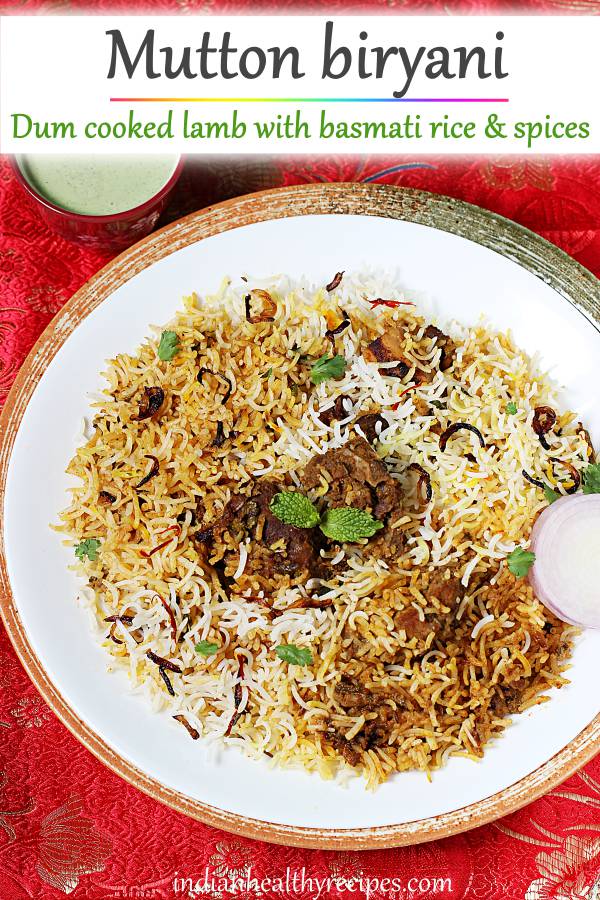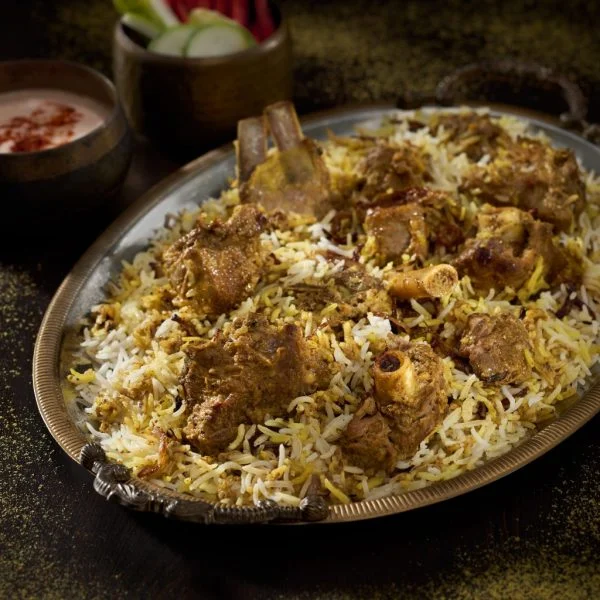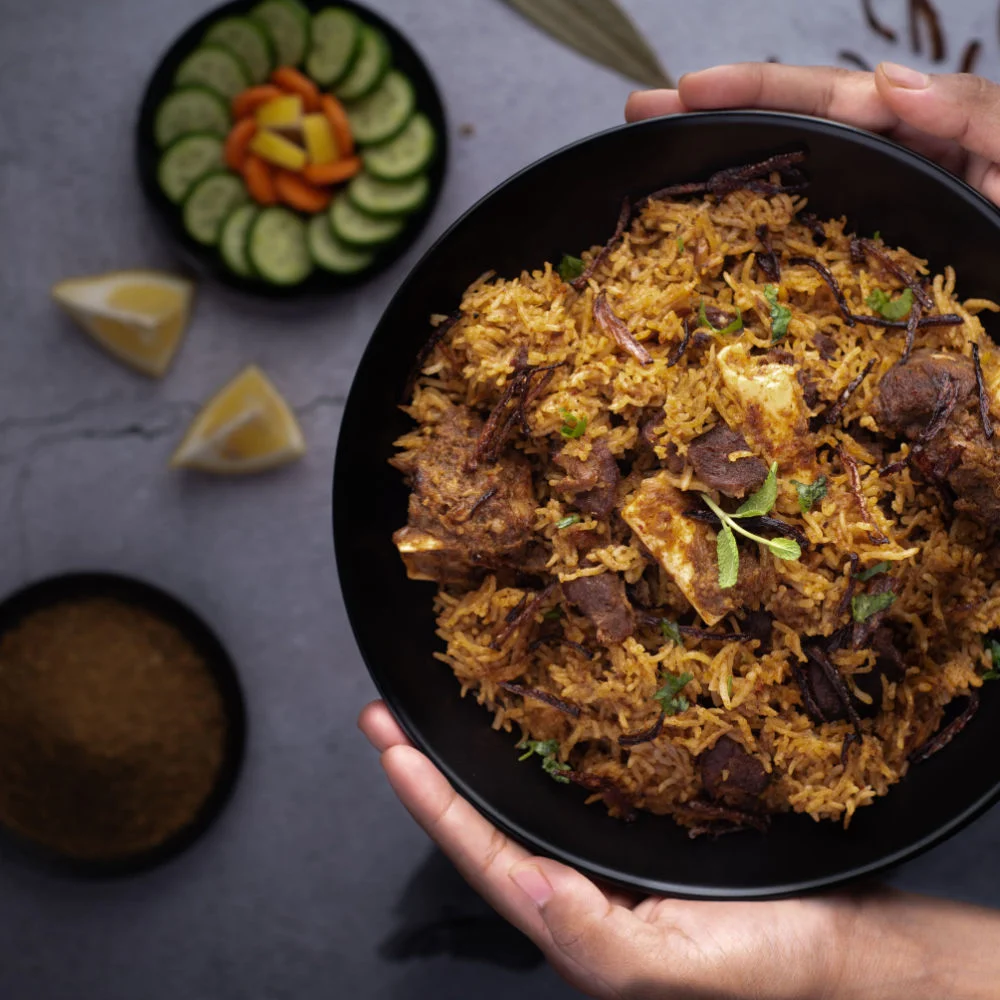Introduction:
In the vast and diverse tapestry of Indian cuisine, few dishes evoke the same level of passion and culinary delight as Mutton Biryani. A fragrant and flavorful rice dish, Mutton Biryani is a masterpiece that tantalizes the taste buds and transports food enthusiasts to a realm of culinary bliss. In this blog post, we embark on a delectable journey to unravel the secrets, history, and the sheer artistry behind the creation of this iconic dish.
Origins of Mutton Biryani:
The origins of Biryani can be traced back to the Mughal era in the Indian subcontinent. The word “Biryani” is derived from the Persian word “Biriyani,” meaning fried before cooking. Mutton Biryani, specifically, emerged as a regal dish, a culinary symphony born in the royal kitchens of the Mughal emperors. Over time, it transcended its aristocratic beginnings to become a beloved dish embraced by people from all walks of life.
Ingredients:
At the heart of any Mutton Biryani recipe lies the perfect blend of spices, tender mutton, and fragrant Basmati rice. The magic begins with a melange of spices such as cardamom, cinnamon, cloves, and bay leaves. The addition of aromatic saffron, ghee (clarified butter), and crispy fried onions elevates the dish to a level of unparalleled richness.
The marination of mutton is a crucial step, allowing the meat to absorb the flavors of yogurt, ginger-garlic paste, and a carefully crafted spice blend. This process ensures that each bite is a succulent burst of flavor.
Layering Technique:
One of the distinguishing features of Mutton Biryani is the layering technique. The rice and marinated mutton are alternately layered in a heavy-bottomed pot, creating a tantalizing marriage of textures and tastes. The use of fragrant water infused with saffron imparts a golden hue to the rice, making each mouthful a visual and gustatory delight.

Dum Cooking:
The crowning glory of Mutton Biryani lies in the dum cooking method. Sealing the pot with a tight-fitting lid and slow-cooking over a low flame allows the flavors to meld, creating a dish where every grain of rice is infused with the essence of the spices and the succulence of the mutton. The result is a biryani that is not merely a dish but a celebration of flavors and textures.


Regional Variations:
Just as India is a land of diverse cultures, Mutton Biryani too undergoes unique transformations as it traverses the length and breadth of the country. The Lucknowi Biryani boasts of the subtlety of Awadhi flavors, while the Kolkata Biryani is known for its use of potato as a key ingredient. The Hyderabadi Biryani, with its spicier profile, and the Malabar Biryani, influenced by the culinary traditions of Kerala, showcase the versatility of this iconic dish.
The Sides:
No exploration of Mutton Biryani is complete without a nod to its accompaniments. Raita, a cooling yogurt-based side dish, complements the spiciness of the biryani. Additionally, a side of salan (a tangy and spicy gravy) or boiled eggs adds an extra layer of indulgence to the meal.
Conclusion:
Mutton Biryani is more than just a dish; it’s a celebration of culinary excellence and cultural diversity. From its royal origins to its ubiquitous presence on dining tables across the subcontinent, Mutton Biryani has stood the test of time as a testament to the artistry of Indian cuisine. So, the next time you savor the aromatic layers of rice and succulent mutton in a plate of Mutton Biryani, remember that you are partaking in a culinary legacy that has delighted palates for centuries.
The Soulful Marinade:
The magic of Mutton Biryani begins with the meticulous process of marination. The mutton, often goat or lamb, is bathed in a luxurious blend of yogurt, ginger-garlic paste, and an assortment of ground spices. This step is crucial, as it allows the meat to soak up the flavors, resulting in tender, succulent pieces that practically melt in the mouth. The marriage of spices in the marinade, including coriander, cumin, and red chili powder, contributes to the distinctive taste that defines a perfect Mutton Biryani.
The Dance of Spices:
Central to the allure of Mutton Biryani is the careful dance of spices that transforms it from an ordinary rice dish into a culinary masterpiece. The fragrant aroma of whole spices like cardamom, cinnamon sticks, cloves, and bay leaves infuses each grain of Basmati rice with a symphony of flavors. The spices, carefully toasted and blended, create a balance that is both bold and nuanced, making each bite a sensory experience.
The Basmati Rice Ballet:
The choice of Basmati rice is pivotal in crafting an exceptional Mutton Biryani. Renowned for its long grains and distinct fragrance, Basmati rice adds a subtle nuttiness that complements the robust flavors of the marinated mutton and aromatic spices. The rice is parboiled to perfection, ensuring that it retains its integrity during the dum cooking process, where it absorbs the essence of the layered ingredients.
Dum Cooking: A Culinary Ritual:
The crowning glory of Mutton Biryani lies in the dum cooking method, a slow-cooking process that takes place in a sealed pot. This technique allows the flavors to meld and intensify, creating a dish that is more than the sum of its parts. As the biryani simmers over a low flame, the meat becomes tender, and the rice absorbs the aromatic essence of the spices. The sealed pot ensures that no aroma escapes, resulting in a biryani that is infused with a richness that is truly unparalleled.

The Art of Layering:
Assembling Mutton Biryani is an art form. The alternating layers of marinated mutton and fragrant rice create a mosaic of flavors and textures. The golden saffron-infused water, drizzled between the layers, imparts a regal hue to the dish, elevating it from a simple rice preparation to a feast fit for royalty. Each spoonful captures the essence of the carefully layered ingredients, offering a harmonious blend of meat, rice, and spices.
Accompaniments: Completing the Ensemble:
No exploration of Mutton Biryani is complete without acknowledging its accompaniments. Raita, with its cool and refreshing yogurt base, provides a delightful contrast to the warmth of the biryani. The side of salan, a tangy and spicy gravy, adds depth to the experience, while the boiled eggs or potatoes, often nestled within the layers, contribute to the symphony of textures.
Conclusion: A Culinary Legacy:
Mutton Biryani is more than a dish; it is a journey through the rich tapestry of Indian cuisine. From the royal kitchens of the Mughals to the bustling streets of cities, its legacy endures as a testament to the artistry of culinary craftsmanship. So, the next time you partake in a plate of Mutton Biryani, savor not just the flavors but the history, tradition, and the sheer artistry that has gone into creating this timeless masterpiece. It’s more than a meal; it’s an ode to the culinary spirit of India.
The history of Mutton Biryani is a fascinating journey that spans centuries, weaving through the cultural tapestry of the Indian subcontinent. Rooted in the opulent kitchens of the Mughal emperors, Mutton Biryani has evolved from a royal indulgence to a beloved culinary masterpiece embraced by people from all walks of life.
Mughal Origins:
The Mughal Empire, which spanned the Indian subcontinent from the early 16th to the mid-19th century, left an indelible mark on the region’s culture, art, and, of course, cuisine. Mutton Biryani is believed to have originated during the Mughal era, a time when the emperors were known for their extravagant lifestyles and refined tastes.
The Persian connection is evident in the name itself, as “Biryani” is derived from the Persian word “Birian,” meaning ‘fried before cooking.’ The Mughal emperors, known for their love of rich, aromatic dishes, played a crucial role in refining and popularizing the art of cooking Biryani.
Royal Indulgence:
Mutton Biryani was initially a dish reserved for royalty and aristocrats. The royal kitchens became laboratories for culinary experimentation, where skilled chefs crafted dishes that were not just a feast for the palate but also a spectacle of opulence. Mutton Biryani, with its layers of fragrant rice, succulent marinated meat, and a symphony of spices, became a centerpiece of these grand banquets.
Migration and Diversification:
As the Mughal Empire began to decline, the culinary traditions of the imperial kitchens dispersed across the subcontinent. Mutton Biryani, once a privilege of the elite, made its way into the homes and kitchens of commoners. With time, regional variations emerged, influenced by local ingredients, spices, and cooking techniques.
Regional Variations:
Each region in India put its unique stamp on Mutton Biryani, resulting in a diverse array of styles and flavors. The Lucknowi Biryani from Uttar Pradesh is known for its subtle and fragrant composition. The Kolkata Biryani, inspired by the Nawabi style, incorporates potatoes into the dish. The Hyderabadi Biryani, with its spicy and aromatic profile, reflects the culinary traditions of the Deccan region. The Malabar Biryani from Kerala showcases the coastal influence with its use of coconut and unique spices.
Contemporary Significance:
Today, Mutton Biryani has transcended its historical roots to become a symbol of communal dining, family celebrations, and festive occasions. It is a dish that bridges generations, connecting modern food enthusiasts with the rich culinary heritage of the past. Whether enjoyed at a festive gathering or savored in the comfort of one’s home, Mutton Biryani continues to be a culinary icon that tells the story of India’s diverse and flavorful history.
Culinary Evolution:
The culinary journey of Mutton Biryani is marked by a continuous evolution, shaped by the hands of skilled chefs, the fusion of diverse influences, and the changing socio-cultural landscape of the Indian subcontinent. As it transitioned from the royal courts to the kitchens of the common man, the dish underwent subtle transformations, adapting to regional palates and ingredient availability.
Colonial Influences:
During the colonial era, particularly under the British Raj, Indian cuisine experienced a confluence of flavors. The British fascination with Indian spices and culinary techniques had a profound impact on the way dishes, including Mutton Biryani, were prepared. The exchange of culinary practices during this period contributed to the richness and complexity of Indian cuisine.
Street Food Phenomenon:
In addition to its aristocratic roots, Mutton Biryani found its way into the bustling streets and markets of India. Street vendors and small eateries began serving this flavorful dish, making it accessible to a wider audience. The street food version often showcased a more rustic preparation, with an emphasis on bold, robust flavors that resonated with the masses.
Cultural Celebrations:
Mutton Biryani became synonymous with celebrations, marking significant cultural and religious festivals. Its presence during weddings, Eid celebrations, and other joyous occasions turned it into a symbol of communal feasting and shared happiness. The dish, with its aromatic allure, became a cornerstone of Indian culinary heritage, transcending regional and cultural boundaries.
Global Recognition:
In recent decades, Indian cuisine, including Mutton Biryani, has garnered international acclaim. As people around the world developed a taste for diverse and exotic flavors, Biryani emerged as a culinary ambassador, representing the rich tapestry of Indian gastronomy. Restaurants and chefs worldwide began to experiment with and showcase their interpretations of this iconic dish.
Modern Adaptations:
In the 21st century, Mutton Biryani has not only retained its cultural significance but has also undergone creative reinterpretations. Modern chefs and home cooks alike experiment with fusion Biryani, incorporating global ingredients while preserving the core essence of the dish. The accessibility of international ingredients, coupled with a growing global interest in diverse cuisines, has contributed to the continued popularity and evolution of Mutton Biryani.
Conclusion:
The history of Mutton Biryani is a saga of culinary excellence, cultural assimilation, and enduring appeal. From the royal courts of the Mughals to the streets of contemporary India, this dish has not merely survived the passage of time; it has flourished, becoming an integral part of the gastronomic identity of the subcontinent. As we savor each aromatic bite of Mutton Biryani, we partake in a tradition that spans centuries, celebrating the artistry and diversity that define Indian cuisine.
Mughal Culinary Mastery:
In the grand kitchens of the Mughal emperors, culinary mastery reached its zenith. Mutton Biryani, born out of this opulence, was a testament to the Mughals’ gastronomic prowess. The use of fragrant spices, meticulous marination, and the innovative dum cooking method set the stage for what would become a culinary legend. The Mughals, known for their appreciation of the finer things in life, crafted a dish that not only satisfied the palate but also reflected their refined taste.
Spice Routes and Trade:
As the Mughal Empire expanded, so did the reach of its culinary treasures. The spice routes that crisscrossed the Indian subcontinent played a crucial role in the spread of Mutton Biryani. Spices like cardamom, cloves, and cinnamon, integral to the dish, became sought-after commodities, contributing to the rich tapestry of global trade during the Age of Exploration.
Royal Legacy:
The decline of the Mughal Empire did not diminish the allure of Mutton Biryani; instead, it transformed the dish into a culinary legacy that transcended imperial boundaries. Nawabs and local rulers continued to patronize the art of Biryani-making, ensuring its preservation and adaptation to regional tastes. The dish, once reserved for emperors, became a symbol of cultural heritage.
Partition and Culinary Diaspora:
The partition of India in 1947 led to mass migrations and the scattering of communities. Mutton Biryani, woven into the cultural fabric of the subcontinent, traveled with families across borders. The dish evolved in response to new environments and ingredient availability, giving rise to distinct regional variations that reflected the diasporic journey of its creators.
Cinema and Popular Culture:
In the latter half of the 20th century, Mutton Biryani found its way into the hearts of people through popular culture, particularly Indian cinema. Bollywood films often depicted grand feasts where Biryani took center stage, cementing its status as a dish associated with celebration, romance, and familial bonds. The on-screen portrayal of Mutton Biryani contributed to its widespread popularity and integration into the culinary imagination of the masses.
Social Media and Culinary Revival:
In the digital age, social media platforms have played a pivotal role in the revival and reinterpretation of traditional dishes. Food bloggers, chefs, and home cooks share their Mutton Biryani recipes, each with a unique twist. The visually appealing nature of the dish, with its vibrant colors and aromatic appeal, has made it a star on Instagram feeds and YouTube channels, attracting a new generation of food enthusiasts.
Conclusion:
The journey of Mutton Biryani through history is a saga of culinary brilliance, cultural resilience, and adaptability. From the imperial kitchens of the Mughals to the global dining tables of today, Mutton Biryani continues to captivate hearts and taste buds. Its enduring legacy is not just about a dish but a celebration of the cultural, historical, and gastronomic richness of the Indian subcontinent. As we relish a plate of Mutton Biryani, we partake in a tradition that has withstood the test of time, connecting us to the flavors and stories of generations past.